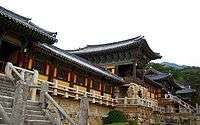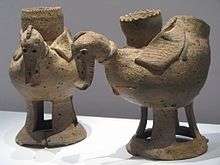Geumgwan Gaya
Geumgwan Gaya (43 - 532), also known as Bon-Gaya (본가야, 本伽倻, "original Gaya") or Garakguk (가락국, "Garak State"), was the ruling city-state of the Gaya confederacy during the Three Kingdoms Period in Korea. It is believed to have been located around the modern-day city of Gimhae, Southern Gyeongsang province, near the mouth of the Nakdong River. Due to its geographic location, this kingdom played a dominant role in the regional affairs from the Byeonhan period onward to the end of the Gaya confederacy.
| Geumgwan Gaya | |
| Hangul | 금관가야 |
|---|---|
| Hanja | 金官伽倻 |
| Revised Romanization | Geumgwan Gaya |
| McCune–Reischauer | Kŭmgwan Kaya |
Part of a series on the |
||||||||
|---|---|---|---|---|---|---|---|---|
| History of Korea | ||||||||
 | ||||||||
| Prehistoric period | ||||||||
| Ancient period | ||||||||
|
||||||||
| Proto–Three Kingdoms period | ||||||||
| Three Kingdoms period | ||||||||
|
||||||||
| Northern and Southern States period | ||||||||
|
||||||||
| Later Three Kingdoms period | ||||||||
|
||||||||
| Dynastic period | ||||||||
|
||||||||
| Colonial period | ||||||||
|
||||||||
| Modern period | ||||||||
|
||||||||
| Topics | ||||||||
| Timeline | ||||||||
According to the Samguk Yusa, Geumgwan Kaya was made of 9 villages united by King Suro of Gaya. His wife and queen Heo Hwang-ok, whom he married in 48 AD, is believed to be from an Ayuta kingdom.[1]
During this early time in the history of Gaya, several waves of migration from the north, including the earlier-extant Gojoseon, Buyeo, and the Goguryeo, arrived and integrated with existing populations and stimulated cultural and political developments. A sharp break in burial styles is found in archaeological sites dated near the late 3rd century AD, when these migrations are to have taken place. Burial forms associated with North Asian nomadic peoples, such as the burial of horses with the dead, suddenly replace earlier forms in the tombs of the elite. In addition, evidence exists indicating that earlier burials were systematically destroyed. In the early 1990s, a royal tomb complex was unearthed in Daeseong-dong, Gimhae, attributed to Geumgwan Gaya but apparently used since Byeonhan times.[2]
After Geumgwan Gaya capitulated to Silla in 532 AD, its royal house was accepted into the Sillan aristocracy (probably because by that time, a major house of Silla, of the Gyeongju Kim clan, was related to the Gaya royal house, which was Gimhae Kim clan) and given the rank of "true bone," the second-highest level of the Silla bone rank system. General Kim Yu-shin of Silla (also of the Gimhae Kim clan) was a descendant of the last king of Gaya.
Gallery
- Gaya horse armour
- Gaya armour
 Gaya crown
Gaya crown Gaya pottery
Gaya pottery
See also
- History of Korea
- List of Korean monarchs
- List of Korea-related topics
- Daegaya
References
- "The Relations Between Korea and India: Korean-Indian Relations in Ancient History." http://www.korea.net/news/issue/attach/PDF%20Format_india_2.pdf, page 3 of 9.
- Cheol, S.K. (2000). Relations between Kaya and Wa in the third to fourth centuries AD. Journal of East Asian Archeology 2(3-4), 112-122.
- Cheol, S.K. (2000). Relations between Kaya and Wa in the third to fourth centuries AD. Journal of East Asian Archeology 2(3-4), 112-122.
- Il, yeon. Garak-gukgi chronicles, Samgukyusa